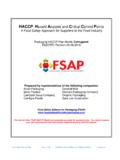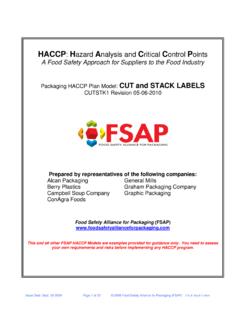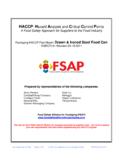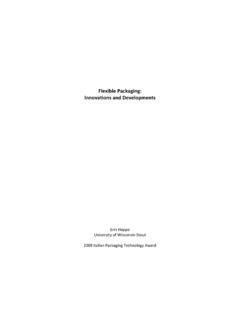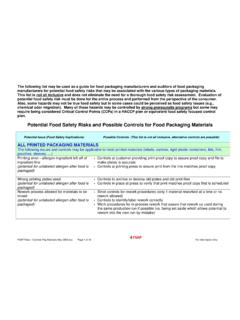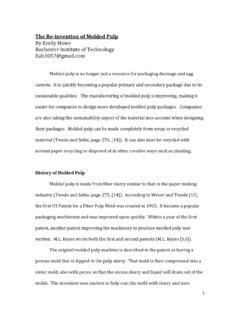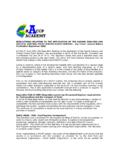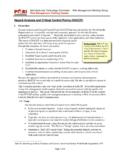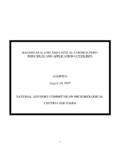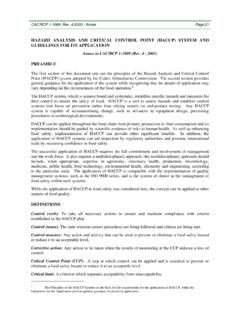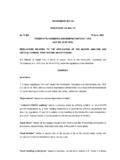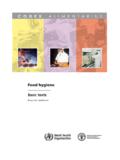Transcription of HACCP Hazard A Control oints - IoPP
1 Issue Date: Sept. 30 2009 Page 1 of 23 2009 Food Safety Alliance for Packaging (FSAP) Rigid Plastics HACCP : Hazard analysis and critical Control Points A Food Safety Approach for Suppliers to the Food Industry Packaging HACCP Plan Model: Rigid Plastics RDGPLA1 Revision 05-06-2010 Prepared by representatives of the following companies: Alcan Packaging General Mills Berry Plastics Graham Packaging Company Campbell Soup Company Graphic Packaging ConAgra Foods Food Safety Alliance for Packaging (FSAP) This and all other FSAP HACCP Models are examples provided for guidance only. You need to assess your own requirements and risks before implementing any HACCP program. Issue Date: Sept. 30 2009 Page 2 of 23 2009 Food Safety Alliance for Packaging (FSAP) Rigid Plastics 1.
2 What is HACCP ? HACCP ( Hazard analysis and critical Control Points) is a systematic approach to the identification, evaluation, and Control of food safety hazards . It is an internationally recognized system used to identify and Control Food Safety hazards . It is a preventative approach to Food Safety developed in the early 1970s by the Pillsbury Company and NASA, the National Aeronautics and Space Administration. 2. Why is HACCP Needed for Packaging Suppliers? Suppliers of packaging to food producing companies are part of the food industry. Food Safety starts at the packaging supplier and continues through consumption. Packaging suppliers, especially those with direct product contact and/or printed materials, are important Food Safety partners. 3. What are the Packaging HACCP Models? The Packaging HACCP Models are a series of publications designed to assist producers of food packaging with the implementation and installation of a HACCP program.
3 They are designed to provide guidance in the development of HACCP plans. The Packaging HACCP Models have been created by the Food Safety Alliance for Packaging (FSAP). Food Safety Alliance for Packaging (FSAP) Initiative: The FSAP Initiative is a project involving major food companies, packaging companies, food industry associations, and consultants. The team s primary goal is to provide guidance to packaging companies with an emphasis on packaging-related Food Safety concerns. The FSAP strives to elevate Food Packaging Safety Awareness and provide resources for tools and training for the Packaging Supply Chain. 4. Who should use them? The Packaging HACCP Models are intended to be used by companies supplying packaging components to food producers. They may be used by those packaging companies that are just beginning to implement HACCP and those wishing to evaluate their existing plan.
4 5. Applying this Model What to Expect Upon reviewing this model and performing the applicable steps listed in sections 11 through 20 of this document, the plant will have implemented a basic HACCP program. The plant can expect to review existing documentation and create new documents. A small multi-disciplinary team will create the HACCP Plan and review and update it at least yearly. Upon following the steps and successfully completing the suggested documentation in this model, the plant s Food Safety program should be enhanced and meet the expectations of your customers. 6. Definitions a. HACCP Plan: The written document which is based upon the principles of HACCP and which requires the procedures to be followed. b. Hazard : A biological, chemical, or physical agent that is reasonably likely to cause illness or injury in the absence of its Control .
5 I. Chemical: , Cleaning Compounds, Allergens, Pesticides, etc. ii. Physical: , Glass, Metal, Plastic, Wood, etc. iii. Microbiological: , Salmonella, Listeria, E. coli, etc. c. Hazard analysis : The process of collecting and evaluating information on hazards associated with the packaging under consideration to decide which are significant and must be addressed in the HACCP plan. A list of hazards associated with raw materials and each process step is compiled. Each Hazard will be evaluated when determining Issue Date: Sept. 30 2009 Page 3 of 23 2009 Food Safety Alliance for Packaging (FSAP) Rigid Plastics critical Control Points. The HACCP Team must consider where the end product will be used. Product safety concerns are considered during the Hazard analysis , not quality concerns. d. CCP: critical Control Point - A step at which Control can be applied and is essential to prevent or eliminate a food safety Hazard or reduce it to an acceptable level.
6 I. CCP Validation/Verification plan: See section 21. e. CP: Control Point - Any step at which biological, chemical, or physical factors can be controlled. f. QCP: Quality Control Point - A step in the process where a quality parameter may be controlled. g. PP: Prerequisite Programs Existing Operating, Environmental, and support systems that allow the plant to produce safe products. Examples include, but are not limited to, Pest Control , Good Manufacturing Practices (GMP), and Preventive Maintenance. Examples and more information are provided in Appendix A. 7. Common Approach for HACCP Implementation Action steps appear as Items 11 20 in this model a. Assemble HACCP Team (multi-disciplinary) See Item 11, Step 1 b. Write Product Description (how is it made and what raw materials are used) See Item 12, Step 2 c. Identify Target Audience (include markets and customers) See Item 12, Step 2 d.
7 Create Process Flow Diagram See Item 13, Step 3 e. Verify Process Flow Diagram See Item 14, Step 4 f. Identify hazards See Item 15, Step 5 g. Perform Hazard analysis See Item 15, Step 5 h. Determine if critical Control Points (CCP) exist (Some processes will not have CCPs) See Item 16, Step 6 1. Use CCP Decision Tree (See Appendix B) i. Establish critical Control Point Limits (if applicable) See Item 17, Step 7 j. Establish Monitoring Procedures for critical Control Points (if applicable) See Item 18, Step 8 k. Establish Corrective Actions for critical Control Point Deviations (if applicable) See Item 19, Step 9 l. Verify HACCP Plan See Item 20, Step 10 8. Applying the Packaging HACCP Model a. This model should be used for any Rigid Plastic Manufacturer who supplies goods and services to the Food Industry b. It must be noted the critical Control Points outlined in this model are only POTENTIAL CCPs.
8 Your plan may/will vary depending on your exact process, programs and customer requirements. 9. HACCP Training Issue Date: Sept. 30 2009 Page 4 of 23 2009 Food Safety Alliance for Packaging (FSAP) Rigid Plastics a. HACCP Team Leader It is recommended that this person has formal training from an accredited organization. (See FSAP website) b. HACCP Team Members Team members should receive formal documented training from the team leader or person knowledgeable in HACCP . c. Plant Employees Should receive documented training upon hiring and at least annually thereafter. d. Those with CCP Monitoring Responsibility Shall receive documented training specific to the CCP they monitor in addition to annually plant-wide training. e. Training Records HACCP training must be documented and the records maintained per the plant record retention policy.
9 10. Record Keeping & Documentation Records provide evidence that procedures are being followed and CCPs are monitored as required. They provide objective evidence to internal and external auditors. As in ISO 9000, if something is not documented, it s not done. a. Types of documents plant will need: Expected documentation is listed in section 11 20 of this model. In short, the plant documentation will include: the HACCP Plan; Hazard analysis ; HACCP Procedures; HACCP Records; a list of HACCP trained personnel and team members; and, supporting documentation from the Prerequisite Programs (Appendix A). b. Completing HACCP Records: HACCP records shall be completed at the time of use. Information shall be recorded in permanent ink. c. Review of HACCP Records: CCP records should be reviewed by a trained company representative prior to releasing an order for shipment.
10 The review must be documented. d. Proper documentation practices: The plant should follow proper documentation practices such as prohibiting the use of correction fluid (Wite-out ) and pencil on permanent records. Also, changes to entries should be made using a single line-out along with initialing and dating the change. A documentation practices procedure should be in place. e. HACCP Record Retention: The plant s record retention policy should include a retention time for HACCP records. In many cases, this will be two years. Issue Date: Sept. 30 2009 Page 5 of 23 2009 Food Safety Alliance for Packaging (FSAP) Rigid Plastics PREPARING YOUR HACCP PLAN 11. Step 1: Assemble HACCP Team a. Cross Functional Team b. Management Sponsorship / Buy-In / Participation c. HACCP Training d. Documents: Team List / Charter with Management Sign-Off / Generic Facility Training Log Facility HACCP Team Facility Name: StanLee Packaging, Marvel Facility Date: June 30, 20XX Team Member Name Department Title HACCP Team Role C.
